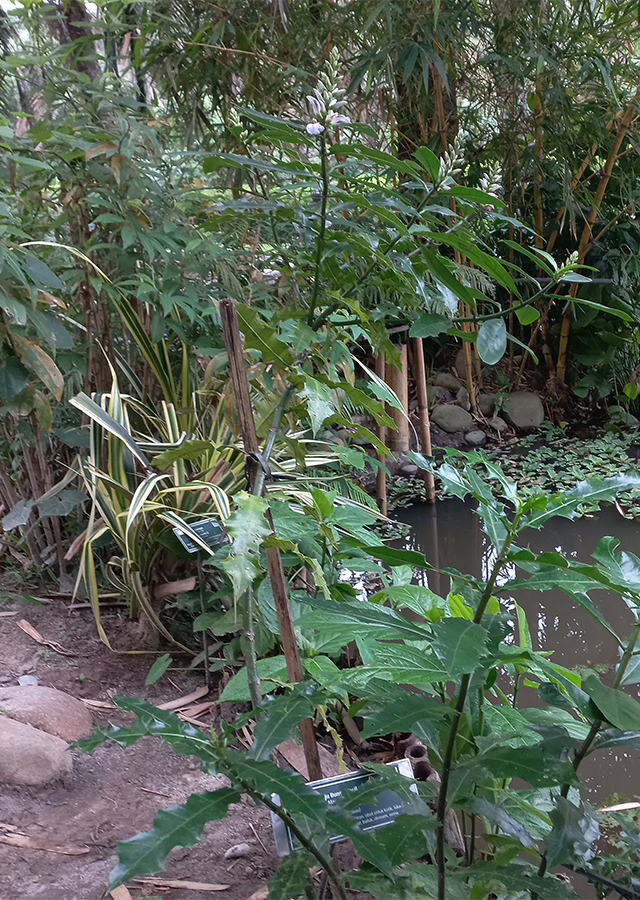Traditional Herbs from Acanthus ilicifolius
treating_beracun_panah_wounds
- Take enough daruju leaves with small purple flowers and wash them until clean.\u00a0
- Crush the leaves until they become a paste.
- Apply it to the wound.
medicating_kidney_stones
- Take the daruju flower plant small amount of purple to taste then wash until clean.\u00a0
- Boil until boiling.
- Strain the boiled product.
- Drink half\u00a0a glass every day until the signs and symptoms disappear.
What is Acanthus ilicifolius Looks like??



Parts of Acanthus ilicifolius that could be used
- Shoots", "Leaves", "Bark", "Roots", "Stems", "All Parts of the Plant
Acanthus ilicifolius Distribution
The small purple flowered daruju is distributed from South India and Sri Lanka to Indo-China, Indonesia, the Philippines, and northern Australia, but is somewhat rare in Malaysia. This plant sometimes forms dense thickets in mangrove swamps that can interfere with logging operations. Burned plant ash is used as an alkali to make soap. This plant can also be used as an ornamental plant. Its spiny leaves make it useful as a barrier plant to block off certain areas of a landscape design. This plant is planted as a marsh plant for the edge of ponds or in sleeping areas in drier conditions. In Ayurvedic medicine, this plant is one of the 9 plants in the medicine 'Sahchara', which is used for rheumatic complaints. Apart from being a medicine for rheumatic complaints, this plant is also an ingredient in traditional medicine for several diseases in several countries.Agroecology of Acanthus ilicifolius
Daruju is a small purple flower plant in tropical areas, which is found near coastlines in areas that have no dry season or a short dry season. This plant grows best in areas where annual daytime temperatures are in the range of 18 - 26 °C, but can tolerate 15 - 32 °C. This daruju prefers average annual rainfall in the range of 1,500 - 2,500 mm, but tolerates 1,000 - 3,000 mm. Prefers a position in full sun, tolerates some shade. Grows best in heavier soils with moderate to high fertility. Tolerant of flooding and fairly high salt levels in the soil. Prefers a pH in the range of 6.8 - 7.2, with a tolerance of 6.5 - 7.5.
Morphology of Acanthus ilicifolius
- Supporting roots may sometimes develop at the bottom of the stem. Often produce adventitious aerial roots.
- The stem\u00a0is shiny green with spots, and a pair of spines at the corners of the leaves.
- The\u00a0short-stemmed leaves have leaf blades spikes that are oval in shape, pale green with a yellowish tinge above and green below.
- Flowers with\u00a0flower shoots reach a length of 20 cm, produce 20 pairs of flowers clustered in four vertical rows at the tips. The pale lilac flowers are 2\u20134 cm long, with three stems (reduced leaves) at the base.
- The 4-seeded fruit is slightly flat, ovate, shiny green, and 2-long. 3 cm. The fruit will explode when ripe to reach 2 m.
- Wrinkled, whitish green seeds that are about 1 cm long.
Cultivation of Acanthus ilicifolius
Propagation can be done generatively by seeds or vegetatively by stem cuttings.
Acanthus ilicifolius, more details :
Chemical Content of Acanthus ilicifoliusResins, alkaloids, sulfuric acid, acancifoliuside, enacteoside, isoacteoside, acanthaminoside, (+)-lyoniresinol 3a-O-ß-glucopyranoside, (-)-lyoniresino, and a-amyrin, (+)-lyoniresinol 3a-[2-( 3,5-dimethoxy-4-hydroxy)-benzoyl]-O- -glucopyranoside, and dihydroxymethyl-bis(3,5-dimethoxy-4-hydroxyphenyl) tetrahydrofuran-9( or 90)-O- -glucopyranoside, 5,11-epoxymegastigma glucoside, megastigma glucoside, (6S, 9S)-roseoside, luteolin 7-O-beta-D-glucuronide, apigenin-7-O-beta-D-glucuronide, methylapigenin-7-O-beta-D-glucuronate, uridine, uracil, flavonoids, phenols, terpenoids, glycosides,7-chloro-(2R)-2-O-ß -D-glucopyranosyl-2H-1,4-benzoxazin-3(4H)-one and (2R)-2-O-ß-D-glucopyranosyl -5-hydroxy-2H-1,4-benzoxazin-3(4H), (+)-lyoniresinol 3α-O-β-D-glucopyranoside, (- )-lyoniresinol 3α-O-β-D-glucopyranoside, (+)-lyoniresinol, 1H-Indole- 3-carboxylic acid, 1H-Indole-3-carboxaldehyde, 1H-Indole-3-acetic acid.
Benefits of Acanthus ilicifolius
Treats acute and chronic hepatitis, enlarged liver and spleen, swollen and enlarged lymph nodes, gastralgia, asthma, helps expectoration, vaginal discharge, gastrointestinal pain, as an emollient for rheumatism, antidote for snake venom, heals wounds, poison arrow wounds, neuralgia, kidney stones. Has activity as an antiseptic and blood cleanser.
Simplisia of Acanthus ilicifolius
- Prepare daruju leaves with small purple flowers, wash thoroughly with running water then drain.
- Dry in the sun or in an oven with a temperature\u00a0to 40\u00b0C water content\u00a010%.
- Choose using a blender until it becomes powder.
- Store in a clean and airtight place.
Another Facts for Acanthus ilicifolius :
Synonym of Acanthus ilicifoliusAcanthus ilicifolius var. typica Domin, Dilivaria ilicifolia (L.) J.St.-Hil.
Habitus of Acanthus ilicifolius
Bush. Annual shrub, up to 3 m high
Habitat of Acanthus ilicifolius
- Wetland
- Coastal
No comments:
Post a Comment